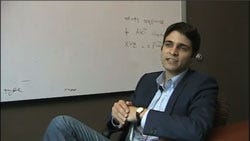NeuroVigil’s CEO Philip Low is working on a version of the company’s sleep monitoring device that gathers data and beams them to a subject’s cell phone. The results can then be sent wirelessly to NeuroVigil for analysis.
September 23, 2010
MIT’s Technology Review has highlighted the work of 35 innovators under age 35. Several researchers from the crop of young talent have made strides in medical technology.
Celeste Nelson, 34, borrowed lessons from in biomedicine the semiconductor world to develop a method for reconstructing tissue structures from scratch. For example, lungs begin as inverted Y–shaped structures in the embryo. Through experimentation, Nelson learned that different shapes play a critical role in how the tissue’s sophisticated architecture develops. For example, starting with a T shape may produce different concentrations of signaling molecules, which then informs the growth of new branches of molecules.
Mikhail Shapiro, 29, is a venture capitalist who cofounded Cyberkinetics, a neurotechnology company. The firm’s objective was to create implantable devices for quadriplegics that would allow them to control external devices with their thoughts. Shapiro was 20 years old when he ran the business side of Cyberkinetics and helped raise $20 million in venture capital funding. The company has since folded, but Shapiro brought the ideas and experience with him, having developed an imaging method for observing the brain’s chemical messengers. Now he is a senior associate with the firm Third Rock Ventures.
In diagnostics, Samuel Sia, 34, developed an inexpensive microfluidic chip that can test blood samples for a variety of diseases. The results are obtained via a small battery-powered device. Sia’s original goal was to bring microfluidics technology to poor or underdeveloped countries, and he organized several field trials for the device in Rwanda. However, finding funding to commercialize the chip has been a challenge.
Biofilms, which are essentially armies of bacteria covered by a protective shield, present a different challenge. Timothy Lu, 29, engineered a virus (called a phage) to get rid of biofilms and break down their defense against antibiotics. His T7 phage invades the top bacterial layer, which causes the bacteria to burst open and spill out enzymes and new phages. The viruses then attack the next layer of bacteria, and so on, until the biofilm is eradicated.
|
Mikhail Shapiro talks to Technology Review about improving interfaces for the brain. |
Some molecules don’t need destroying—they just need a little transformation. Kyoto University researchers figured out how to turn skin cells into induced pluripotent stem (iPS) cells three years ago. To get to the heart of sickle-cell anemia, Jacob Hanna, 30, took skin cells from a diseased mouse and reprogrammed them to generate iPS cells. After being reimplanted, the mouse started producing healthy red blood cells on its own. This development could have significant implications for humans. Hanna is investigating new types of human stem cells for his research.
Another young innovator investigated algorithms for sleep studies. Philip Low, 31, created an algorithm that classifies the various stages of a person’s sleep using data from a single EEG lead. Low subsequently created NeuroVigil, a company that makes a sleep-monitoring device using the technology. The device comes in handy for pharmaceutical firms, which use it to monitor patients for brain-related side effects when patients are treated for central nervous system disorders. Low hopes that EEG signatures may eventually be used to warn of conditions such as schizophrenia and Parkinson’s disease before symptoms manifest.
About the Author(s)
You May Also Like



